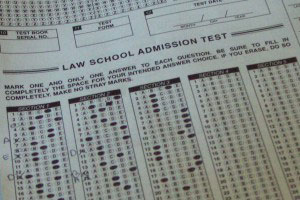 The Argument Section on the LSAT requires a brain in critical thinking mode. This article by Magoosh outlines why it is such an important section. You must be able to identify the author’s conclusion, or the point they are trying to make, as well as the evidence used to support that argument. In this article we will focus on the evidence, also called the author’s premise. Let’s consider this example:
The Argument Section on the LSAT requires a brain in critical thinking mode. This article by Magoosh outlines why it is such an important section. You must be able to identify the author’s conclusion, or the point they are trying to make, as well as the evidence used to support that argument. In this article we will focus on the evidence, also called the author’s premise. Let’s consider this example:
Law School News and LSAT Strategy
Stay current with the latest law school admissions news and proven LSAT strategies.
Posts about LSAT mindset (4):
LSAT Tip of the Week: Understanding the Author's Conclusion
The Argument Section on the LSAT requires a critically trained brain. Most importantly, you must be able to identify the author’s conclusion, or the point they are trying to make, as well as the evidence used to support that argument. In this article we will focus on the conclusion. Stay tuned for next week's tip on identifying the author's evidence, or premise.
LSAT Tip of the Week: How to Read an Argument
The Argument Section of the LSAT, also known as the logical reasoning section, is made up of 24 to 26 arguments. Helpful LSAT course sites like 7Sage usually include an...
LSAT Tip of the Week: Logic Games
 With the new year comes new habits, and create these new habits around how you will approach and attack the LSAT. This week, spend a few hours each day reviewing logic games. This section can seem daunting to some, but in reality it is the easiest to master if you just can get a little faster at them and master the rules. Through some trial and error, here is what I found to be the most efficient way to complete a logic game. Two overarching ideas to keep in mind: (1) stay organized and (2) write legibly. Nothing is more frustrating than trying to decode your own handwriting and thoughts while already facing something as mind-consuming as a logic game. First, read the question and then diagram on the right side of the page where the individual questions are. This will save you precious time from scanning back and forth. Make sure you label the diagram you create for each question as well, helping you stay organized, and ensuring they are not too large or complex. The biggest tip to remember though is to simply memorize the rules. The LSAT questions, minus a few outliers, follow a set fact-pattern and rule that has been established already. Spot these rules, memorize these rules, and know them like the back of your hand. Keeping all of this in mind you can make the logic games your best section in no time.
With the new year comes new habits, and create these new habits around how you will approach and attack the LSAT. This week, spend a few hours each day reviewing logic games. This section can seem daunting to some, but in reality it is the easiest to master if you just can get a little faster at them and master the rules. Through some trial and error, here is what I found to be the most efficient way to complete a logic game. Two overarching ideas to keep in mind: (1) stay organized and (2) write legibly. Nothing is more frustrating than trying to decode your own handwriting and thoughts while already facing something as mind-consuming as a logic game. First, read the question and then diagram on the right side of the page where the individual questions are. This will save you precious time from scanning back and forth. Make sure you label the diagram you create for each question as well, helping you stay organized, and ensuring they are not too large or complex. The biggest tip to remember though is to simply memorize the rules. The LSAT questions, minus a few outliers, follow a set fact-pattern and rule that has been established already. Spot these rules, memorize these rules, and know them like the back of your hand. Keeping all of this in mind you can make the logic games your best section in no time.
LSAT Tip of the Week: The Arguments Section
The Arguments Section of the LSAT, also known as the logical reasoning section, tests an important skill: your ability to read critically and closely. Here is a good ...
Big LSAT Changes in 2018?
 The Law School Admissions Council (LSAC) is a monolithic and conservative entity befitting a gatekeeper of legal academia. However, it’s beginning to be forced to change with the times in the face of some significant challenges. The number of LSATs administered annually has declined by more than a third this decade from 170,000+ at the end of the 2009-10 testing year to fewer than 110,000 during the 2016-17 testing year. Then came the news that, beginning with applications submitted in the fall of 2017, Harvard Law will accept the GRE as an acceptable alternative to the LSAT for incoming applicants.
The Law School Admissions Council (LSAC) is a monolithic and conservative entity befitting a gatekeeper of legal academia. However, it’s beginning to be forced to change with the times in the face of some significant challenges. The number of LSATs administered annually has declined by more than a third this decade from 170,000+ at the end of the 2009-10 testing year to fewer than 110,000 during the 2016-17 testing year. Then came the news that, beginning with applications submitted in the fall of 2017, Harvard Law will accept the GRE as an acceptable alternative to the LSAT for incoming applicants.
